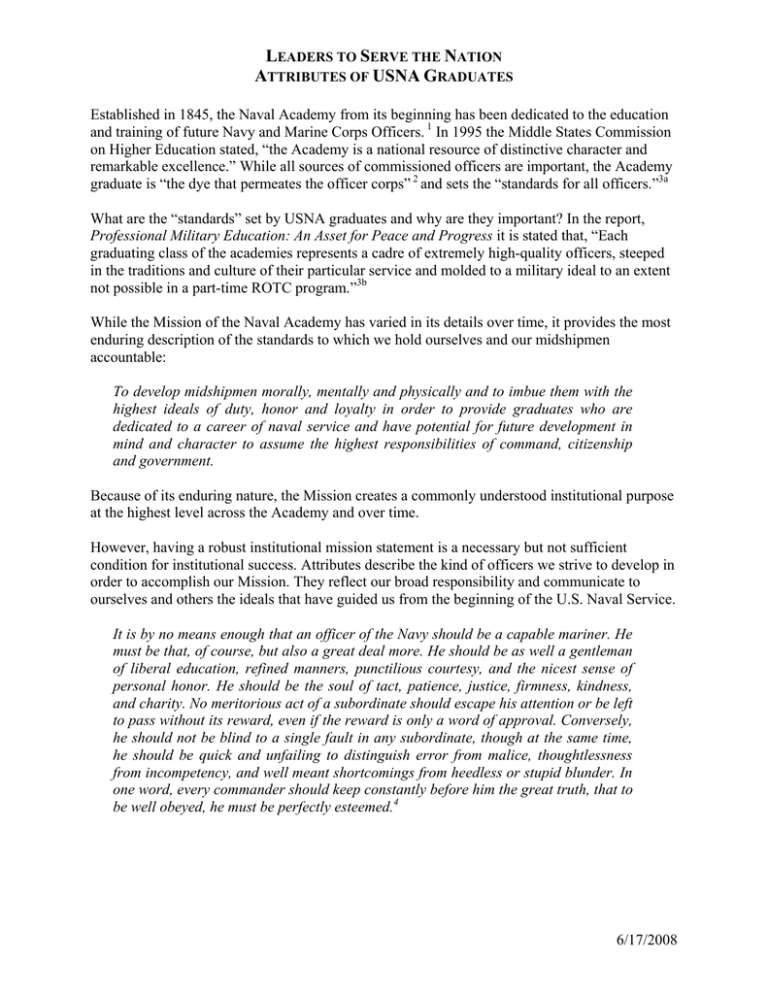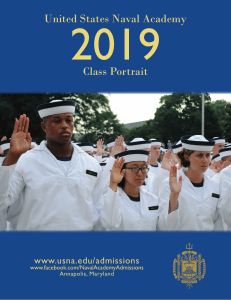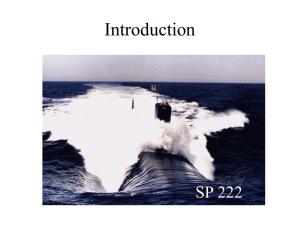L S N A
advertisement

LEADERS TO SERVE THE NATION ATTRIBUTES OF USNA GRADUATES Established in 1845, the Naval Academy from its beginning has been dedicated to the education and training of future Navy and Marine Corps Officers. 1 In 1995 the Middle States Commission on Higher Education stated, “the Academy is a national resource of distinctive character and remarkable excellence.” While all sources of commissioned officers are important, the Academy graduate is “the dye that permeates the officer corps” 2 and sets the “standards for all officers.”3a What are the “standards” set by USNA graduates and why are they important? In the report, Professional Military Education: An Asset for Peace and Progress it is stated that, “Each graduating class of the academies represents a cadre of extremely high-quality officers, steeped in the traditions and culture of their particular service and molded to a military ideal to an extent not possible in a part-time ROTC program.”3b While the Mission of the Naval Academy has varied in its details over time, it provides the most enduring description of the standards to which we hold ourselves and our midshipmen accountable: To develop midshipmen morally, mentally and physically and to imbue them with the highest ideals of duty, honor and loyalty in order to provide graduates who are dedicated to a career of naval service and have potential for future development in mind and character to assume the highest responsibilities of command, citizenship and government. Because of its enduring nature, the Mission creates a commonly understood institutional purpose at the highest level across the Academy and over time. However, having a robust institutional mission statement is a necessary but not sufficient condition for institutional success. Attributes describe the kind of officers we strive to develop in order to accomplish our Mission. They reflect our broad responsibility and communicate to ourselves and others the ideals that have guided us from the beginning of the U.S. Naval Service. It is by no means enough that an officer of the Navy should be a capable mariner. He must be that, of course, but also a great deal more. He should be as well a gentleman of liberal education, refined manners, punctilious courtesy, and the nicest sense of personal honor. He should be the soul of tact, patience, justice, firmness, kindness, and charity. No meritorious act of a subordinate should escape his attention or be left to pass without its reward, even if the reward is only a word of approval. Conversely, he should not be blind to a single fault in any subordinate, though at the same time, he should be quick and unfailing to distinguish error from malice, thoughtlessness from incompetency, and well meant shortcomings from heedless or stupid blunder. In one word, every commander should keep constantly before him the great truth, that to be well obeyed, he must be perfectly esteemed.4 6/17/2008 LEADERS TO SERVE THE NATION Mission accomplishment demands the elaboration of the mission into guiding principles and behaviors that are readily understandable and actionable by all members of the community. The guiding principles we have adopted have taken the form of attributes of graduates. They are the more concrete manifestations of the concepts embodied in the mission statement. A concise list of attributes was first generated in conjunction with the 1999 USNA Strategic Plan. There were earlier strategic plans that to some extent provided this focus (June 1992, June 1993, Jan 1997), but what was unique about the 1999 plan was its explicit connection with resource allocation and institutional renewal. The process of reaching consensus on the statement of the 1999 strategic vision for the Naval Academy involved extensive stake holder feedback early in the planning process and repeated “testing” and revision of draft statements of attributes that clearly described what we expect of our graduates. This plan provided a vision and guiding principles that served to give broad focus on how the Naval Academy executes its mission. The creation of the current list of attributes, which is derived from the 1999 attributes, involved active participation of many USNA constituents led by the newly established Academy Effectiveness Board (AEB). The AEB is a standing committee of the Senior Leadership Team (SLT) and is co-chaired by the deputies of the senior leaders responsible for achieving the mission, namely, the Academic Dean and Provost, Commandant, and Athletic Director. The list of attributes generated through extensive internal input during spring 2006 was then reviewed by the Senior Leadership Team during the fall 2007 semester and, eventually, by the Chief of Naval Operations’ staff. As a result of these reviews the following was approved in April 2008: We accomplish our mission by graduating midshipmen who are warriors ready to meet the demands of a country at war or at peace. In this sense our graduates are: • Selfless leaders who value diversity and create an ethical command climate through their example of personal integrity and moral courage. • Mentally resilient and physically fit officers, who inspire their team to accomplish the most challenging missions, including leading in combat. • Technically and academically proficient professionals with a commitment to continual learning. • Critical thinkers and creative decision makers with a bias for action. • Effective communicators. • Adaptable individuals who understand and appreciate global and cross-cultural dynamics. • Role models dedicated to the profession of arms, the traditions and values of the Naval Service and the constitutional foundation of the United States. There are primarily three interconnected uses of the attributes of graduates: first, to communicate to ourselves and others the ideals that should shape our programs over the 47 months that midshipmen spend at the Naval Academy; second, to foster programmatic alignment at the Naval Academy with the desired end states that the attributes represent; and, third, to guide strategic planning, resource allocation, institutional renewal, and institutional effectiveness assessment. Through the leadership in word and deed of the Superintendent, Academic Dean, Commandant, Athletic Director and all members of the USNA Senior Leadership Team the attributes will remain the enduring legacy of a Naval Academy education whereby our graduates set the standards for all officers. 2 LEADERS TO SERVE THE NATION References 1 Department of Defense Directive Number 1322.22. Subject: Service Academies. August 24, 1994. 2 The Higher Standard: Assessing the United States Naval Academy. Report of the Special Committee to the Board of Visitors, United States Naval Academy. June 1997, page 6 3 Professional Military Education: An Asset for Peace and Progress. A report of the CSIS Study Group of on Professional Military Education, Washington, D.C.: Center for Strategic & International Studies. March 1997 a. page 28; b. page 27. 4 Statement long attributed to Jones, but now believed to have been written by Augustus C. Buell. Reef Points: 2003-2004, 98th Edition, U.S. Naval Academy, 2003 3



